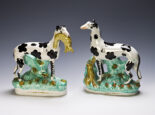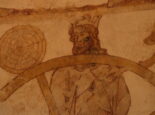The Katharine of Aragon Festival 2019 | The Aragon Connection
The Katharine of Aragon Festival 2019 | The Aragon Connection 1 2
[prev] … around various Royal residences, but never to one at which the King was also present. Despite considerable public support for Katharine – Anne was often jeered by crowds – coupled with political weight in her favour – at a time when going against the King was more likely to result in a severed head than a change of mind – Henry continued to ostracise his wife, even refusing to accept the 1532 New Year’s gift of a gold cup she sent him. In January 1533, Henry finally wedded Anne, albeit in secret. The marriage to Katharine was finally judged invalid, by an English court with no input from Rome, inMay of that year. Anne was nowQueen of England. Katharine wasn’t, being given the title Dowager Princess of Wales instead. This only recognised her marriage to Arthur, so many years previously, and effectively implied that her 24 years as Henry’s wife had never taken place. Katharine herself never accepted this and continued to regard herself as true Queen. The slights continued; when Anne gave birth to a daughter, later to become Queen Elizabeth I, in September 1533, Katharine’s child Mary was stripped of her Princess title.
THE BREAK WITH ROME
In March 1534, the Pope finally declared that the marriage to Henry had been legal after all and excommunicated both the King and the Archbishop of Canterbury. The Royal response was the Act of Supremacy, which effectively broke the Church of England completely away from Rome, with the monarch as its head, answerable only to God. Katharine steadfastly refused to recognise this, despite the threat of execution for treason. She continued to be shuffled around the country, but when an attempt was made to move her to Somersham on the Isle of Ely, which was notorious for its unhealthy conditions, she barricaded herself in her room. In May 1534, she did consent to move to Kimbolton, just down the Great North Road from Peterborough. Although more comfortable than any of her previous imposed residences, she fell ill the following year and died on January 7, 1536, aged 50. In attendance was Maria de Salinas, the lady-in-waiting who had accompanied her 35 years previously from Spain.
“The reason the Reformation happens is, first of all, Katharine’s failure to produce a son. But above all, and what we’ve forgotten, is that this is not the final trigger. It is her refusal to give up on her marriage.” – Dr David Starkey
Controversy surrounded her death; there were rumours she’d been poisoned (although it seems likely cancer was the real cause) and the day after her demise, Henry and/or Anne – accounts disagree on quite who, or whether it was actually both – appeared in flamboyant yellow. This was regarded as in poor taste by many, although others have suggested that it was the Spanish colour of mourning. Henry is said to have shed tears when he received her final letter to him in which she called him ‘her most dear lord, King and husband’ and further wrote ‘For my part, I pardon thou everything, and I desire to devoutly pray God that he will pardon thou also. For the rest, I commend unto thou our daughter Mary, beseeching thou to be a good father unto her, as I have heretofore desired… Lastly, I makest this vow, that mine eyes desire thou above all things.’ Her will requested that she be buried at the convent of the Franciscan Observant Friars, but with the Dissolution of the Monasteries underway – a direct result of the split with Rome – this no longer existed.
Henry decided a state funeral at St Paul’s was too expensive and that she should be buried in Peterborough Abbey instead. Her funeral cortege left Kimbolton on January 27, arriving in Peterborough the following day. In scenes perhaps reminiscent of 1997, huge crowds of well-wishers lined the route of the official Princess of Wales and the unofficial Queen of England as she made her final journey. She was buried on January 29, during a magnificent ceremony. Robert Scarlett, Peterborough’s legendary gravedigger who reputedly provided the inspiration for William Shakespeare’s gravedigger in Hamlet, did the honours. Henry did not attend and neither did he allow her daughter Mary.
On the day of the funeral, Queen Anne miscarried a son; the loss of this male heir is said to be a contributory factor in her execution by Henry less than six months later. Katharine’s influence continued. She continued to be regarded as a stoic and generous paragon of womanhood and the best-loved of Henry’s wives. Her daughter Mary did eventually become Queen in 1553, although her violent efforts to re-establish Roman Catholicism in England earned her the nickname ‘Bloody Mary’ and hundreds were burned at the stake during her brief five-year reign. She was succeeded by Elizabeth I.
“I’ve always admired her as a historical figure of integrity. I always thought that she was telling the truth, and now I think it’s almost certain that she was.” – ALISON WEIR
Shakespeare made Katharine a major character in his play Henry VIII, although when it was staged at London’s Globe Theatre in 1613, a spark from a stage cannon burnt the place down. However, she was indirectly responsible for saving Peterborough Abbey from potential destruction; three years after her death, the Dissolution of the Monasteries reached the city. Instead of suffering the fate of many religious houses and being ransacked or even demolished, the abbey was made a new cathedral instead. Although the strategic efforts of its abbot, John Chambers, were largely responsible for its preservation, it’s likely that the presence of Katharine’s tomb was a contributory factor. However, just over 100 years later, the cathedral was attacked by Cromwell’s troops during the Civil War; among the monuments they destroyed was Katharine’s tomb. It took two centuries until a new marble slab was put in place, following an appeal to the women of England who shared her Christian name. The lettering above it reads simply ‘Katharine, Queen of England’ rather than the title Henry forced upon her. Alongside is a wooden plaque, put up by the citizens of Peterborough on the 450th anniversary of her death and paying tribute to her as ‘A Queen cherished by the English people for her loyalty, piety, courage and compassion.’
The Katharine of Aragon Festival will be held from January 25 to 27. See next page for a guide to events, or for a fully updated programme visit www.peterborough-cathedral.org.uk/katharine2019.aspx
● The Katharine of Aragon Festival is a collaboration between Peterborough Cathedral and Vivacity Peterborough.
The Katharine of Aragon Festival 2019 | The Aragon Connection 1 2















